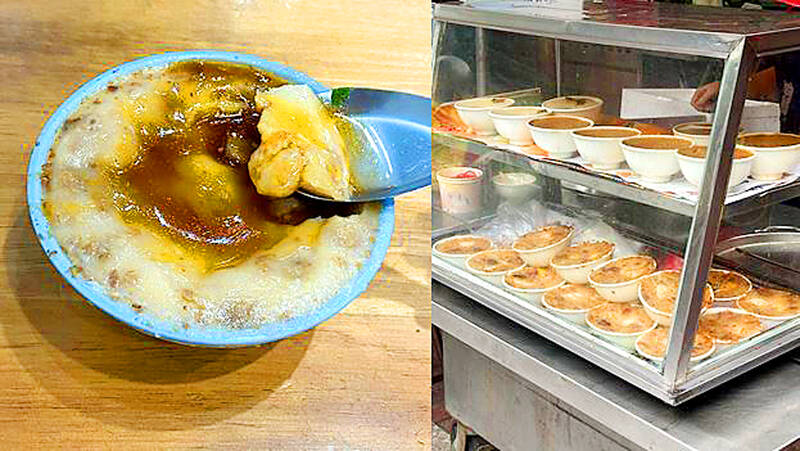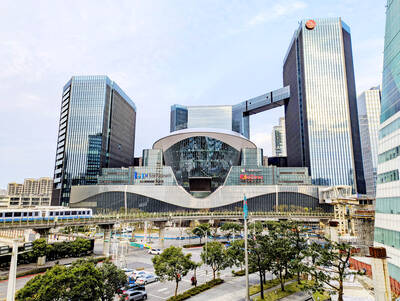Rice is an essential ingredient in Taiwanese cuisine. Many foods are made of rice, adding more variety to our cooking, such as rice cake, or “gui.” Wagui is made by steaming rice flour batter in a bowl. The term “gui” refers to a type of food made from rice, while “wa” refers to a bowl. The pronunciation of “gui” in Taiwanese Hokkien is similar to the word for “nobility” in Chinese, so it is common for people to prepare various types of gui, including wagui, as offerings to the gods or ancestors,.
米是台灣重要的主食,用米製成的食品十分多元,豐富我們的飲食,如米做成的「粿」。粿的意思是米做成的糕點,碗粿是將在來米漿倒入碗中蒸熟,因而得名。粿因為音同「貴」,因此碗粿等粿食常用作供品祭拜神明和祖先。
nobility (n.) 高貴,高尚;貴族

Photo: Bookman l 圖片:書林
offering (n.) 供品
While Taiwan may not be a large island, there are still many types of wagui based on the ingredients they use. For example, a sweet version of wagui is a Hakka people’s snack made by adding dark brown sugar to the rice flour batter. Furthermore, in northern Taiwan, another Hakka style wagui which has a savory taste is commonly found in traditional markets. Its rice flour batter is steamed without any seasoning, resulting in a smooth and white appearance. The Hakka wagui is often topped with minced pork and dried pickled daikon and drizzled with soy sauce, giving it a simple yet satisfying taste by allowing the rice flavor to shine through.
台灣雖不大,但碗粿的滋味卻是十分豐富,像是在米漿中加入黑糖的客家甜碗粿,還有常在北部菜市場看到的客家鹹碗粿,其米漿不經調味料即蒸熟,外觀白色平滑。鋪上絞肉、菜脯等配料,並淋上醬油,滋味樸實卻能突顯米的清香。
seasoning (n.) 調味料,佐料
shine through (v. phr.) 顯露
Compared to the light flavor of the Hakka version, Tainan’s wagui is known for its many ingredients and stronger flavor. The rice flour batter is steamed with cooked ingredients like sliced soy eggs, velvet shrimp, shiitake mushrooms and braised minced pork. This rice cake has a richer taste and darker appearance that is often referred to as “black wagui,” while the Hakka version is referred to as “white wagui.” After being steamed, a sweet thick soy sauce is put on top of black wagui to enhance the flavor. Locals in Tainan typically pair wagui with floating milkfish in thick soup, while migao is commonly served with fish ball soup. This custom has been passed down through generations and is still followed by many today.
和清爽的客家碗粿相比,台南碗粿特色是豐富配料,粉漿中會加入切片滷蛋、火燒蝦、香菇、肉燥一起蒸熟,讓粿本身也帶有鹹味,粿的外觀呈褐色,因而有「黑碗粿」之稱,北部的則稱為「白碗粿」。蒸好之後然後淋上甜的醬油膏,台南人吃碗粿時還會點浮水魚羹,吃米糕則搭配魚丸湯,這是自古流傳下來的習慣。
To make wagui, start by stirring a mixture of rice flour and hot water until it thickens. Then, pour the batter into bowls, which give wagui its bowl-like shape, and steam it. Since freshly-steamed wagui doesn’t have the best texture, wagui has traditionally been left to cool overnight after steaming, which results in the tender and chewy texture that many people prefer.
碗粿要怎麼做呢?先將在來米粉和水攪拌至濃稠後,倒入碗中蒸熟,因此碗粿造型才像是碗一樣。但剛蒸好卻不是最美味的,以前的碗粿是前一天晚上蒸好,冷卻後隔天再拿來吃,才會是大家愛吃的軟Q碗粿。
mixture (n.) 混合物
thicken (v.) 變厚,變密,變濃
文章由書林出版公司提供:
www.bookman.com.tw

A: Yet another shopping mall has just opened in Taipei. B: Do you mean the Mitsui Shopping Park LaLaport Nangang? A: Yeah, the shopping mall run by Japanese Mitsui & Co. opened last week. B: I hear the mall features about 300 stores, Vieshow Cinemas and Japanese Lopia supermarket. A: With the opening, a war is breaking out between Taipei’s department stores. A: 台北又有新的購物商場可逛啦。 B: 你是說Mitsui Shopping Park LaLaport 南港? A: 對啊這家日本三井集團旗下的商場上週開幕。 B: 聽說商場有威秀影城、樂比亞日系超市,還有多達300家專櫃。 A: 新商場一開幕,看來又要掀起一場百貨大戰啦! (By Eddy Chang, Taipei Times/台北時報張迪)

A: Hey, didn’t you go to the opening of the Mitsui Shopping Park LaLaport Nangang last week? B: Yeah, there are about 300 shops, including the first overseas branch of Japan’s Mahou Dokoro — a famous Harry Potter-themed store. A: Wow, I’ve always wanted to get a magic wand. B: There are also a bunch of great restaurants, such as Smart Fish hotpot restaurant. A: I wish I had Harry Potter’s “apparition” and “disapparition” magic, so I could teleport to the mall right now. A: 你上週不是有去LaLaport南港的盛大開幕嗎?有什麼特別的? B: 那裡有多達300家專櫃,包括魔法之地的海外首店——它可是日本知名的《哈利波特》專賣店。 A: 哇我一直想買根魔杖。 B: 另外還有各式各樣的美食,像是林聰明沙鍋魚頭。 A: 真希望我也有哈利波特的「現影術/消影術」魔法,能瞬間移動到商場去! (By Eddy Chang, Taipei Times/台北時報張迪)

When it comes to movies, some people delight in watching spine-chilling horror films. Surprisingly, apart from containing a few scares, horror movies may also offer an unexpected __1__. According to a study, watching 90 minutes of a scary movie can burn an average of 113 calories, which is roughly __2__ to taking a 30-minute walk. Researchers from the University of Westminster carried out an experiment in which they __3__ participants’ oxygen intake, carbon dioxide output, and heart rates while they were watching horror movies without any distractions. The results revealed that physiological responses to fear play a crucial role

Dos & Don’ts — 想想看,這句話英語該怎麼說? 1. 你覺得這部電影怎樣? ˇ What do you think of the movie? χ How do you like the movie? χ How do you think of the movie? 註︰What do you think of = What is your opinion of。 think 的受詞是 what,不能用 how。 2. 你認為哪一個歌星唱得最好? ˇ Which singer do you think is the best? χ Do you think which singer is the best? 註︰英語中 which singer 似乎是 do you think 的受詞,實則 do you think 是插入語,其他例子如下: 你以為他喜歡誰? Who do you think he likes? 你以為我住在哪裏? Where do you think I live? 你想我昨天在公園裏碰到了誰? Whom/Who do you think I met in the park yesterday? 3. 他不論到什麼地方,總是帶著一把雨傘。 ˇ No matter where he goes, he